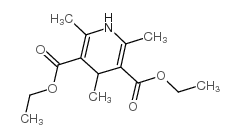Diethyl 1,4-dihydro-2,4,6-trimethyl-3,5-pyridinedicarboxylate

Diethyl 1,4-dihydro-2,4,6-trimethyl-3,5-pyridinedicarboxylate structure
|
Common Name | Diethyl 1,4-dihydro-2,4,6-trimethyl-3,5-pyridinedicarboxylate | ||
|---|---|---|---|---|
| CAS Number | 632-93-9 | Molecular Weight | 267.32 | |
| Density | 1.12g/cm3 | Boiling Point | 335ºC at 760 mmHg | |
| Molecular Formula | C14H21NO4 | Melting Point | 130-132 °C(lit.) | |
| MSDS | Chinese USA | Flash Point | 123.3ºC | |
| Symbol |

GHS07 |
Signal Word | Warning | |
|
Brugia malayi infective larvae fail to activate Langerhans cells and dermal dendritic cells in human skin.
Parasite Immunol. 37(2) , 79-91, (2015) Filarial infection in humans is initiated when a mosquito deposits third-stage parasite larvae (L3) in the skin. Langerhans cells (LCs) and dermal dendritic cells (DDCs) are the first cells that the parasite encounters, and L3s must evade these highly effecti... |
|
|
Controlling the misuse of cobalt in horses.
Drug Test. Anal. 7(1) , 21-30, (2015) Cobalt is a well-established inducer of hypoxia-like responses, which can cause gene modulation at the hypoxia inducible factor pathway to induce erythropoietin transcription. Cobalt salts are orally active, inexpensive, and easily accessible. It is an attrac... |
|
|
Aberrant expression of claudin-4 and -7 in hepatocytes in the cirrhotic human liver.
Med. Mol. Morphol. 48(1) , 33-43, (2015) The liver comprises hepatocytes and non-parenchymal cells such as bile duct epithelial cells. Claudin-4 and -7 are not expressed in hepatocytes under physiological conditions. It was reported that claudin-7 increased in human pulmonary fibroses. We therefore ... |
|
|
Jasmonic acid-isoleucine formation in grapevine (Vitis vinifera L.) by two enzymes with distinct transcription profiles.
J. Integr. Plant Biol. 57 , 618-27, (2015) The plant hormone jasmonic acid (JA) is essential for stress responses and the formation of reproductive organs, but its role in fruit development and ripening is unclear. Conjugation of JA to isoleucine is a crucial step in the JA signaling pathway since onl... |
|
|
Absence of keratin 8 or 18 promotes antimitochondrial autoantibody formation in aging male mice.
FASEB J. 29 , 5081-9, (2015) Human mutations in keratin 8 (K8) and keratin 18 (K18), the intermediate filament proteins of hepatocytes, predispose to several liver diseases. K8-null mice develop chronic liver injury and fragile hepatocytes, dysfunctional mitochondria, and Th2-type coliti... |
|
|
Comparative analysis and modeling of the severity of steatohepatitis in DDC-treated mouse strains.
PLoS ONE 9(10) , e111006, (2014) Non-alcoholic fatty liver disease (NAFLD) has a broad spectrum of disease states ranging from mild steatosis characterized by an abnormal retention of lipids within liver cells to steatohepatitis (NASH) showing fat accumulation, inflammation, ballooning and d... |
|
|
Oxidative stress as common trait of endothelial dysfunction in chorionic arteries from fetuses with IUGR and LGA.
Placenta 36 , 552-8, (2015) Fetal macrosomia and intrauterine growth restriction (IUGR) associate with increased morbidity in the neonate. Placental vascular relaxation is impaired in fetal macrosomia, as well as in IUGR, and this could result from increased oxidative stress present in ... |
|
|
Subcellular localization of PUMA regulates its pro-apoptotic activity in Burkitt's lymphoma B cells.
Oncotarget 6 , 38181-94, (2015) The BH3-only protein PUMA (p53-upregulated modulator of apoptosis) is a major regulator of apoptosis. It belongs to the Bcl-2 family of proteins responsible for maintaining mitochondrial outer membrane integrity by controlling the intrinsic (mitochondrial) ap... |
|
|
Consequences of the loss of the Grainyhead-like 1 gene for renal gene expression, regulation of blood pressure and heart rate in a mouse model.
Acta Biochim. Pol. 62 , 287-96, (2015) The Grainyhead-like 1 (GRHL1) transcription factor is tissue-specific and is very highly expressed in the kidney. In humans the GRHL1 gene is located at the chromosomal position 2p25. A locus conferring increased susceptibility to essential hypertension has b... |
|
|
Disulfiram-induced cytotoxicity and endo-lysosomal sequestration of zinc in breast cancer cells.
Biochem. Pharmacol. 93(3) , 332-42, (2015) Disulfiram, a clinically used alcohol-deterrent has gained prominence as a potential anti-cancer agent due to its impact on copper-dependent processes. Few studies have investigated zinc effects on disulfiram action, despite it having high affinity for this m... |